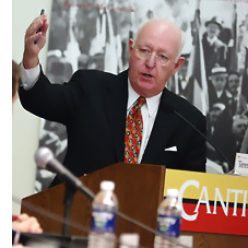Mark it down: April was when the wheels finally came off the Trump bandwagon.
After weeks of rambling, largely incoherent performances in the daily White House coronavirus briefings, punctuated by assaults on the media generally and individual reporters occasionally, President Donald Trump went into total meltdown on Thursday, April 23. That was when he mused, in spontaneous free-association, about the possible merits of ingesting disinfectants and projecting sunlight and ultraviolet light into the body to counteract the virus.
“I’m not a doctor,” he said, belaboring the obvious and tapping his temple, “but I’m, like, a person that has a good you-know-what.” Even for a “very stable genius,” as the President has described himself in the past, it was an extraordinary moment. Sitting off to one side, Deborah Birx, who is a doctor and the coronavirus response coordinator, was a study in self-restraint as she looked down at her hands folded in her lap.
In the momentary silence that followed, you could almost feel White House aides, Trump supporters and Republicans around the country cringing. This time, the President had strayed into clearly dangerous, life-threatening territory with no obvious escape route. This time, his Teflon coating had failed to protect him.
Even President Trump realized his blunder. The next day, he cut the White House briefing short and walked out without taking any questions; the next day he tweeted that he was too busy to attend the briefing. But by Monday, he was back in the limelight.
“You know, I can’t really explain it,” Maryland’s Republican Governor Larry Hogan said on one of the Sunday shows when asked about the President’s Thursday comments. Hogan, who has been careful and measured in his own statements on the virus, added: “It does send a wrong message…when you just say something that pops into your head.”
That is apparently what the President did. Aides reported later that he had attended part of a technical briefing just before the news conference on the impact of bleach and other disinfectants and sunlight on the virus. No one was suggesting this as a medical treatment for humans, but Trump took it there in his comments, urging the medical experts to test whether it could kill the virus in people.
You would not expect anyone to take this wacky idea seriously, but calls to state and local medical departments about it spiked in the immediate aftermath of the President’s off-the-cuff remarks.
The whole incident underscores a more fundamental question: why is this President — really, any President — briefing the nation on such a vital, highly complicated, public health issue as the Covid 19 pandemic? The answer in this case, of course, is that everything President Trump does is about President Trump. In this locked-down, socially-distant world, he is not able to hold the big, noisy political rallies that he enjoys so much. The daily briefings have been the substitute, an opportunity to lie, exaggerate and mislead, while making wildly-inflated claims about his Administration’s performance.
Instead, the nation should be briefed by medical and public health officials, who actually know what they are talking about, and who should be in a position to make the crucial decisions on testing and managing the pandemic that only the Federal government can make. Drs. Anthony Fauci and Birx have played that role, but only as supporting players to the President, who remains front and center.
Such is the consequence of our imperial presidency. As Congress has ceded more and more power to the executive in recent decades, we have created an impossibly demanding role for the President, any President. The man in the Oval Office — so far, all 45 have been men — is called upon to decide war and peace and, in the case of the corona virus, life and death.
No one, man or woman, can fulfill this limitless role. No one person can be the decider-in-chief on everything. Perhaps, in the wake of this virus, the nation can re-balance: Congress can reassert itself and the professional civil service can be given greater responsibility and authority in crises where expertise is crucial.
Perhaps.
